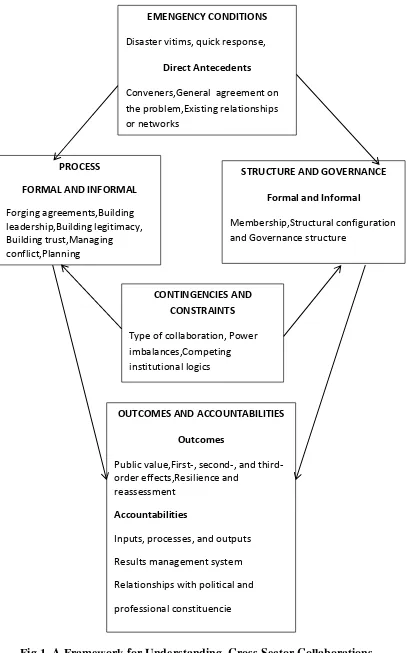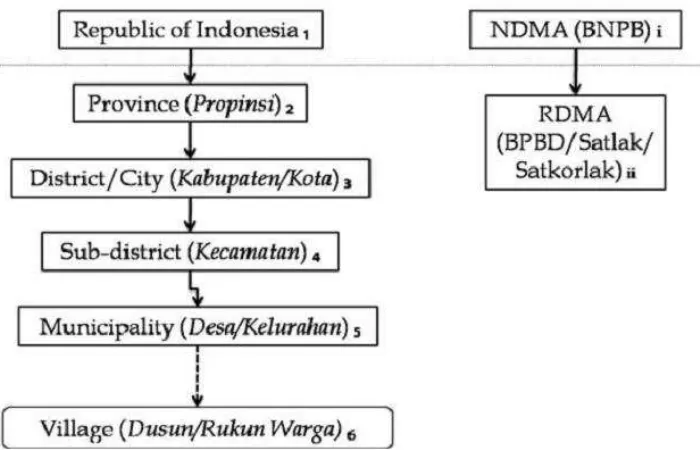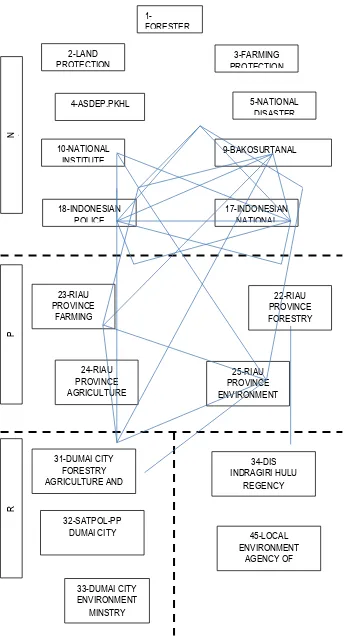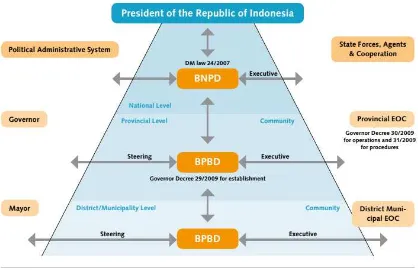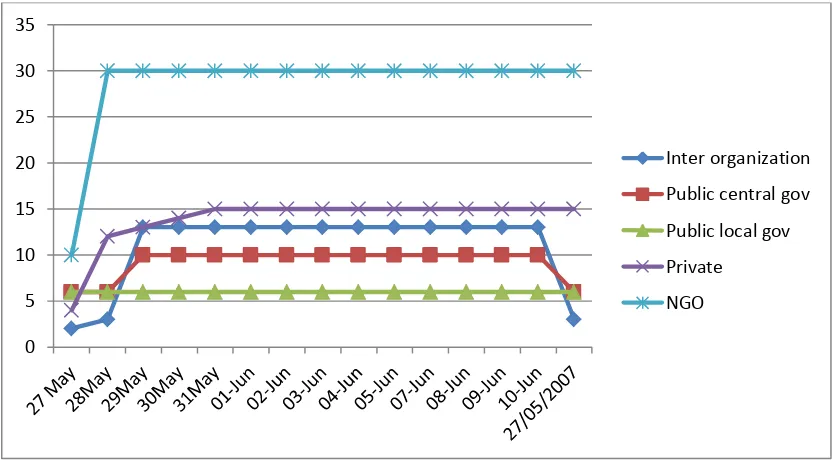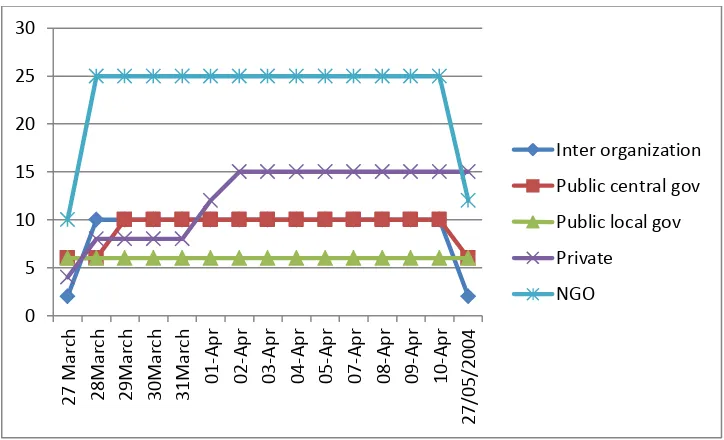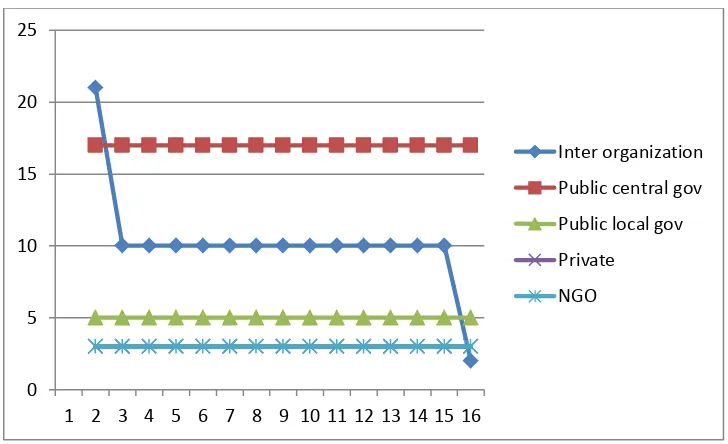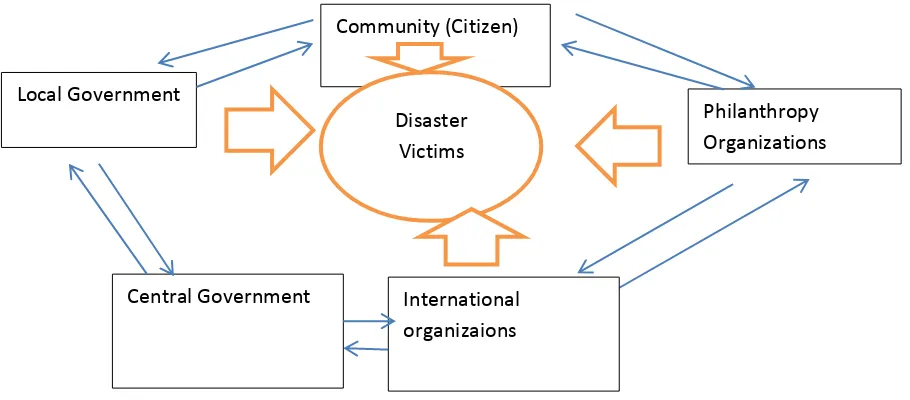Comparing Cross-Sectoral Governance in Managing Post-Disaster in
Indonesia *
1)
The case Study of Way Ela Dam bursts, Forest Fire in Sumatera, Kelud and Merapi Volcano Eruption and Acheh’s Tsunami
Achmad Nurmandi, Zuly Qodir, Eko Poernomo and Isnaini Muallidin
JK School of Government, Universitas Muhammadiyah Yogyakarta
Email: nurmandi_achmad@ymail.com
ABSTRACT
The cross-sector governance or interorganizational network in the emergency and post disaster stage is new area of study in public administration. As a vulnerable state, Indonesia has been trying to set up a cross-sectoral governance in delaing with disaster since 2007. By reviewing the documentary data of previous disaster, we try to compare the cross sectoral governance in managing the disaster victims. We found that Indonesia government implemented cross sectoral disaster governance in Acheh, Merapi and Kelud Volcano, and Way Ela Dam burst. The different disaster were happened in al around Indonesia created the different new model cross sectoral governance.
Keywords: governance, cross sectoral governance, emergency, disaster.
Introduction
With 17,000 islands and over 80,000 kilometers of coast, Indonesia is vulnerable to sea-level rise and myriad natural disasters. Floods are the most the common hazard, but the unpredictability and wide-spread devastation caused by earthquakes, tsunamis and volcanic eruptions make geological disasters much more threatening (www.giveasia.org). The World
Bank has estimated that 40 percent of the country’s population, or around 90 million people,
are vulnerable to disasters .
On December 26 December 2004 earthquake occurred at 00:58:53 with an epicentre off the west coast of Sumatra, Indonesia. The event is known by the scientific community as the Sumatra–Andaman earthquake. An then, the May 2006 Java earthquake occurred at 05:54 local time on 27 May on the southern coast of the island of Java, around 20 km (12 mi) south-southeast of the Indonesian city of Yogyakarta.
Way Ela is a natural dam made in July 13, 2012 because of landslides that closed river stream in Negeri Lima village, Leyhitu sub-district, Central Maluku district, Maluku province. The size of the dam is 1,100 meters long, 300 meters wide, 215 meters high and 35
meters deep. Many argue that the thickness of the dam is good enough. However, the fact showed that the thickness is not a guarantee. Due to the heavy rain, the dam completely broke at around 12:25pm local time on Thursday, July 25, 2013 and five minutes later about 19.8M m3 of water swiped Negeri Lima village which located about 2.25 KM from the dam.
The government through BNPB (National Disaster Management Office) and BPBDs (Provincial and District Disaster Management Offices) provided good facilitation and support to the affected people as soon as possible. The government needs to review again whether the dam construction is in accordance with the needs. Extreme weather / climate change should be taken into consideration. The government should find a way to relocate local communities who live too close to the danger zones. Every disaster creates the formal change of cross-sector organizational relationship, either in community, private sector or government. Change can be classified as primarily linked to formal responses (governments, legal interventions, amendment of organizational structures) and informal responses (individual groups, households, often occurring at very local levels) (Birkmann, 2008). Change and reorganization within and after disasters or perturbations are also two key factors when dealing with newer concepts of resilience linked to coupled social-ecological systems (Folke 2006, p. 257; Berkes et al.2003; Holling2003).
In this paper, we try to compare the cross-sector governance or interorganizational network in the emergency and post disaster stage, namely Way Ela Dam bursts, Forest Fire in Sumatera, Kelud and Merapi Volcano Eruption and Acheh’s Tsunami. How do cross-sectoral governance in the those different setting disasters of Indonesia?
Theoretical Framework
Fig.1. A Framework for Understanding Cross-Sector Collaborations PROCESS
FORMAL AND INFORMAL
Forging agreements,Building leadership,Building legitimacy, Building trust,Managing conflict,Planning
STRUCTURE AND GOVERNANCE
Formal and Informal
Membership,Structural configuration and Governance structure
CONTINGENCIES AND CONSTRAINTS
Type of collaboration, Power imbalances,Competing institutional logics
EMENGENCY CONDITIONS
Disaster vitims, quick response, Direct Antecedents
Conveners,General agreement on the problem,Existing relationships or networks
OUTCOMES AND ACCOUNTABILITIES
Outcomes
Public value,First-, second-, and third-order effects,Resilience and
reassessment Accountabilities
Source: John M . Bryson, John M, et al (2006) The Design and Implementation of Cross-Sector Collaborations: Propositions from the Literature, Public Administration Review • December Special Issue
Emengency Condition
Birkmann, et al’s (2008) work on the impact of disaster on organizational change in Indonesia and Srilanka found that the change in organizational structures, such as the creation of Disaster Management Centre, and in social policy, leading to relocation or migration. The coordination of the reconstruction process after tsunami was managed by a newly created agency called Reconstruction and Rehabilitation Agency of Aceh and Nias (BRR) which was established by the President based on Government Regulation Substituting a Law No.2/2005. The BRR asked all 438 registered NGOs to submit activity reports with the agency. By mid-September 2005, a mere 128 reports had been submitted (BRR, 2005).
Process
We focus on six: forging initial agreements, building leadership, building legitimacy, building trust, managing conflict, and planning (Bryson, 2006). The initial agreement should start with the creation of new organization or mechanism dealing with emergency situation. Due to many organizations involved in helping disater victims, those actors or unit try to set up a potential leader or select legilimate leading organization. In case of Kobe, there were two consequences: an emerging sense of self-governance, and stronger sense of community solidarity (Tatsuki and Hayashi, 1999). Change and reorganization within and after disasters or perturbations are also two key factors when dealing with newer concepts of resilience linked to coupled social-ecological systems (Folke 2006, p. 257; Berkes et al.2003; Holling, 2003). In the next phase, cross-organizations needs the leading sector which guide dynamic problems. The role of leading sector would be likely sponsors and champions (Crosby and Bryson 2005a). Sponsors are individuals who have considerable prestige, authority, and access to resources they can use on behalf of the collaboration, even if they are not closely involved in the day-to-day collaborative work. Those roles encourage legitimacy and trust and managing conflict.
Structure and Governance
network organizations works, they try to set up the structure and mechanism to coordinate each others. One organizations which has power to lead networking to arrange cooperation.
CONTINGENCIES AND CONSTRAINTS
When disaster coming, every organization try to lead operation without smoth cooperation with others, so the conflict amongts them take in places. Indeed, there are power imbalance in those organizations. However, there are power imbalances among collaborating partners as a source of mistrust and therefore a threat to effective collaboration (Huxham and Vagen, 2005). Important differences exist among partnerships formed for system-level planning (identifying and defining system problems and solutions), administrative activities (involving resource transactions, such as staff sharing), or service delivery (such as client referral agreements) (Bolland and Wilson 1994). Collaborations involving system-level planning activities are likely to involve the most negotiation, followed by collaborations focused on administrative-level partnerships and service delivery partnerships (Bryson, e al, 2006).
Research Method
This research is comparative study in nature trying to investigate the differences amongts the practice of governance at post disater in handling emergency events namely dam bursts, mount explotion and the biggest disaster of Tsunami. The data collected in this study is extracted and compiled from the previous study done by some reseachers before, content analysis of news reports, government documents, and after-action reports was conducted. The main goal of the content analysis was to find the performance of intergovernmental and interorganizational response to the catastrophic disasters. However, reseachers have collected primary data on Way Ela Dam bursts in Ambon between September-October 2014.
Finding and Analysis
Emergency Condition: Pushing Factors of New Governance
Comparing the different emergency situation and location of disaster, we found that all cases created the new governance in handling the problems. However, uncoordinated governance and a polycentric and multi-layered architecture which matches closely the decentralization system in Indonesia and would offer favourable conditions for multi-level work procedures and a coordination mechanism (Seng, 2012). Way Ela Dam burst has increased local and multi-layered organization since local government has been given discretion to resolve problems in local disaster.
district, Central Maluku on July 13, 2012, which were not followed up the National Disaster Mitigation Agency (BNPB), the Maluku governor and the Central Maluku regent. Due to a lack of response, Surono again sent a field team on Oct. 18, 2012 to conduct a more detailed inspection. Early warning system runs well. When the dam was in critical condition one day before on Wednesday, July 24, 2013, warning alerts was sounded and government instructed local communities to go to the evacuation centers that have been provided. The government through BNPB (National Disaster Management Office) and BPBDs (Provincial and District Disaster Management Offices) provided good facilitation and support to the affected people as soon as possible. The governor led the emergency response and provided full support to the affected people. Preparedness trainings for floods have been conducted, therefore, local communities aware when evacuation should be started.
Meanwhile, in mount explotion emergency response, Indonesia has long experience. The early warning system at Merapi and Kelud is the same as at all volcanoes in Indonesia and is basedon the analysis of instrumental and visual observations. It comprises 4 alert levels: Level I indicates the activity of the volcano is in normal state, with no indication of increasing activity, although poisonous gases may threaten the area close to the vent or crater. Level II is set when visual and seismic data indicate that the activity is increasing. Level III is set when a trend of increasing unrest is continuing and there is concern that a dangerous eruption may occur. Level IV is set when the initial eruption starts (i.e., ash/vapor erupts which may lead to a larger and more dangerous eruption). The alert level is declared to the public through National Agency for Disaster Management (BNPB) and the local governments (Surono, et al, 2012).
Fig 2. Administrative divisions (1 –6) and disaster management agency in Indonesia (i– ii)
Source: Mei, Estuning Tyas Wulan and Franck Lavigne (2012), Influence of the institutional and socio-economic context 2006 eruptions of the Merapi Volcano, Indonesia for responding to disasters: case study of the 1994, 2012; v. 361; p. 171-186 Geological Society, London, Special Publications
Source: Sukrismanto, Erly (2011), Study on Interorganizational Relationships in the Organizing System of Forest/Land Fire Control in Indonesia, Jurnal Penelitian Hutan Tanaman,Vol.8 No. 3 Juli 169 - 177
In the case of Tsunami in Acheh, there were multilayered and actors involved in post disaster. However, a key problem in implementing a multi-hazard approach is institutional and organizational challenges (Seng, 2012), namely fragmented and dispersed and more time is needed to develop an integrated framework for the separate hazard EWSs; services are produced under different departments and there are challenges to bringing together the different products and services; the geographical occurrence of hazards and disasters; the lack of leadership and adequate resources to implement a multi-hazard framework approach in Indonesia. Process: Learning Process
Analysing the governance process, we try to classify into initial agreements, building leadership, building legitimacy, building trust, managing conflict, and planning. Indonesia has long experience in handling mount explotion case. When the disater come, every organization engages in rescueing the victims. The situation will be likely chaos situation, in which no one organization to be a leader. Otherwise, in the country has long experience in handling disater, Indonesia, has the esthablished organizations. New stakeholders and policy communities often become involved in reconstruction or rehabilitation of affected regions and create through their needs, priorities, and agendaschanges that are unpredictable and this involvement of new actors is a significant feature of learning processes (Birkmann, et al,2008)
However, the post Merapi’s mount eruption, the local governance and central governance has contingency plan which was not adequate to overcome the crisis, because the coverage area of the safety zone was smaller than the areas to be evacuated during the 2010 eruptive crisis (Mei, et, 2010). Therefore, the community try to help themselves by organizing some local organization, form example in crisis communication. The role of local associations was not only limited to aids distribution but also for crisis communication, as exemplified by the actions of Jalin Merapi, a local association supported by several NGOs
working in Merapi’s flanks. Jalin Merapi (Merapi Circle Information Networks) in the 2010 Merapi eruption can empower themselves through participation in providing, sharing, and verifying the information within their social network (Gultom and Joyce, 2012).
leadership is often (although by no means universally) fairly strong, intelligent, responsible and honest with a real basis in popular trust (MacRae and Hodgkin, 2010). In Acheh and Srilanka, Birkmann, et all (2008) found that new stakeholders and policy communities often become involved in reconstruction or rehabilitation of affected regions and create through their needs, priorities, and agendas changes that are unpredictable and this involvement of new actors is a significant feature of learning processes.
Structure and Governance
Fig.4. Regulation and Administrative System of Disaster Management in Indonesia
Source: Seng, Denis Chang (2012), The Role of Risk Governance, Multi-Institutional Arrangements and Polycentric Frameworks for a Resilient Tsumani Early Warning System in Indonesia, Dissertation, published at http://hss.ulb.uni-bonn.de/2010/2227/2227.htm
Fig 5. Actors involved in response to Acheh Earthquake, 24 Dec 2004, to 24 May 2005
Fig 8. Actors involved in response to Forest Fire in Riau (16 days)
Twenty one organizations were from international-parish level organizations, and 30 organizations were from the central level and only 6 organizations from local governments involved in managing the Acheh post disaster. It is noteworthy that the dominant group is private organizations, with 25 organizations. Figure 5-8 depicts the number of organizations involved in disaster response operations of the different disaster for the one year or less period. Indonesia is well prepared for volcanic emergencies, with over 130 active volcanoes, and major recent eruptions at both Sinabung (on Sumatra) and Merapi or Kelud (on Java); a theme picked up both by the Indonesian press, and in social media posts
Outcomes and Accountabilities
A regular documentation system will be developed, and country-level monthly reports will be prepared, which should include different issues, as decided by the core working group (Shaw, 2006). A tension between the requirements of INGOs in terms of transparency, accountability and administrative procedures and real urgent needs on the ground, especially during the emergency phase (MacRae and Hodgkin, 2010). Mechanisms for assessing whether recovery funds were well spent are often weak or missing. A potential solution is to adapt and apply the processes and protocols of performance auditing and performance measurement to recovery and reconstruction – identifying risks and controls, setting measurable targets, assessing whether sustainability and survivability goals are met (Labadie, J. R. (2008).
Discussion
Fig.9. The Pattern of Cross Sectoral Disaster Governance
Conclusion
The vulnerable to sea-level rise and myriad natural disasters Indonesia requires that public managers know more than governance management methods. Public administrators must learn to solve problems within the cultural, structural, and political boundaries of networks, partnerships, and collaborations while still managing the boundaries of their own home organization (Kapucu, 2010). The international organizational and inter-national level organizational relationship among these agencies and the unfaltering need for a coordinated effort from these agencies supports the growth and implementation of networks, partnerships, and collaborations as modalities for addressing new policy issues. Compartmentalized and specialized agencies and administrative functions have served as the rule, leaving open unmet needs (Kapucu, 2010). The different disaster were happened in al around Indonesia created the different new model cross sectoral governance.
References
Aceh and Nias Rehabilitation and Reconstruction Board 2005
Berkes F, Colding J, Folke C (eds) (2003) Navigating social-ecological systems, building resilience forcomplexity and change. Cambridge University Press, Cambridge
Birkmann, et al (2008) Extreme events and disasters: a window of opportunityfor change? Analysis of organizational, institutionaland political changes, formal and informal responses after mega-disasters, Nat Hazards.
Community (Citizen)
Local Government
Central Government
Philanthropy Organizations Disaster
Victims
John M . Bryson, John M, et al (2006) The Design and Implementation of Cross-Sector Collaborations: Propositions from the Literature, Public Administration Review • December Special Issue
Canny, Bill (2006), A Review NGO Coordination in Post Earthquke/Tsunami, ICVA.
Comfort, Louise K. (2005) Comfort Asymmetric Information Processes in Extreme Events: The 26 December 2004 Sumatran Earthquake and Tsunami, Prepared for presentation to Workshop 21: Crisis and Politics, European Consortium for Political Research Universidad de Granada, Granada, Spain.
Djalante, et al (2012), Pathways for Adaptive and Integrated Disaster Resilience,
Gultom, Dwie, Irmawaty andZita Joyce (2012), Crisis communication capacity for disaster resilience: Community participation of information providing and verifying in Indonesian volcanic eruption.
Holling CS (2003) The backloop to sustainability. In: Berkes F, Colding J, Folke C (eds) Navigating socialecological systems, building resilience for complexity and change. Cambridge University Press, Cambridge
Huxham, Chris and Siv Vangen ( 2005), Managing to Collaborate: " The Theory and Practice of Collaborative Advantage. New York : Routledge .
Emergency Plan of Action (EPoA) Indonesia: Volcanic Eruption – Mt Kelud, www.ifrc.org. Folke C (2006) Resilience: the emergence of a perspective for social-ecological systems analyses. Glob Environ Change 16(3):253–267
Kapucu, Naim, et al (2010), Examining Intergovernmental and Interorganizational Response to Catastrophic Disasters : Toward a Network-Centered Approach, Administration and Society, 42:222.
Kusumastuti, et al (2010), Relief Logistics Practices in Indonesia: A Survey,Department of Management, Faculty of Economics and Business University of Indonesia, Depok 16424, Indonesia,September 23, 2010
Labadie, J. R. (2008). Auditing of post-disaster recovery and reconstruction activities. Disaster Prevention and Management: An International Journal, 17(5), 575-586.
Mei, et al (2010), CRISIS MANAGEMENT DURING THE 2010 ERUPTION OF MERAPI VOLCANO,
Ophiyandri, T, (2008) Community Based Post Disaster Housing Reconstruction: Indonesian Perspective, Working Paper, University of Salford.
M. Surono, Philippe Jousset, John Pallister, Marie Boichu, Maria Fabrizia Buongiorno,et al.. The 2010 explosive eruption of Java's Merapi volcano - a '100-year' event.Journal of Volcanology and Geothermal Research, Elsevier, 2012, 241-242, pp.121-135.
Seng, Denis Chang (2012), The Role of Risk Governance, Multi-Institutional Arrangements and Polycentric Frameworks for a Resilient Tsumani Early Warning System in Indonesia, Dissertation, published at http://hss.ulb.uni-bonn.de/2010/2227/2227.htm
Shaw, Rajib and Katsuihciro Goda (2004), From Disaster to Sustainable Civil Society: The Kobe Experience, Disasters, 28(1): 16–40
Shaw, Rajib (2006).Indian Ocean tsunami andaftermath Need for environment-disaster synergy in the reconstruction process,Disaster Prevention and Management,Vol. 15 No. 1, pp. 5-20
Sukrismanto, Erly (2011), Study on Interorganizational Relationships in the Organizing System of Forest/Land Fire Control in Indonesia, Jurnal Penelitian Hutan Tanaman,Vol.8 No. 3 Juli 169 - 177
Teguh, Mochamad (2011), Sharing Experiences and Lessons Learned in Disaster Management System in Indonesia, Asian Transactions on Engineering (ATE ISSN: 2221-4267) Volume 01 Issue 05.
